Assignment On RXMAN Hospital.
VerifiedAdded on 2022/09/25
|20
|4073
|17
Assignment
AI Summary
Contribute Materials
Your contribution can guide someone’s learning journey. Share your
documents today.
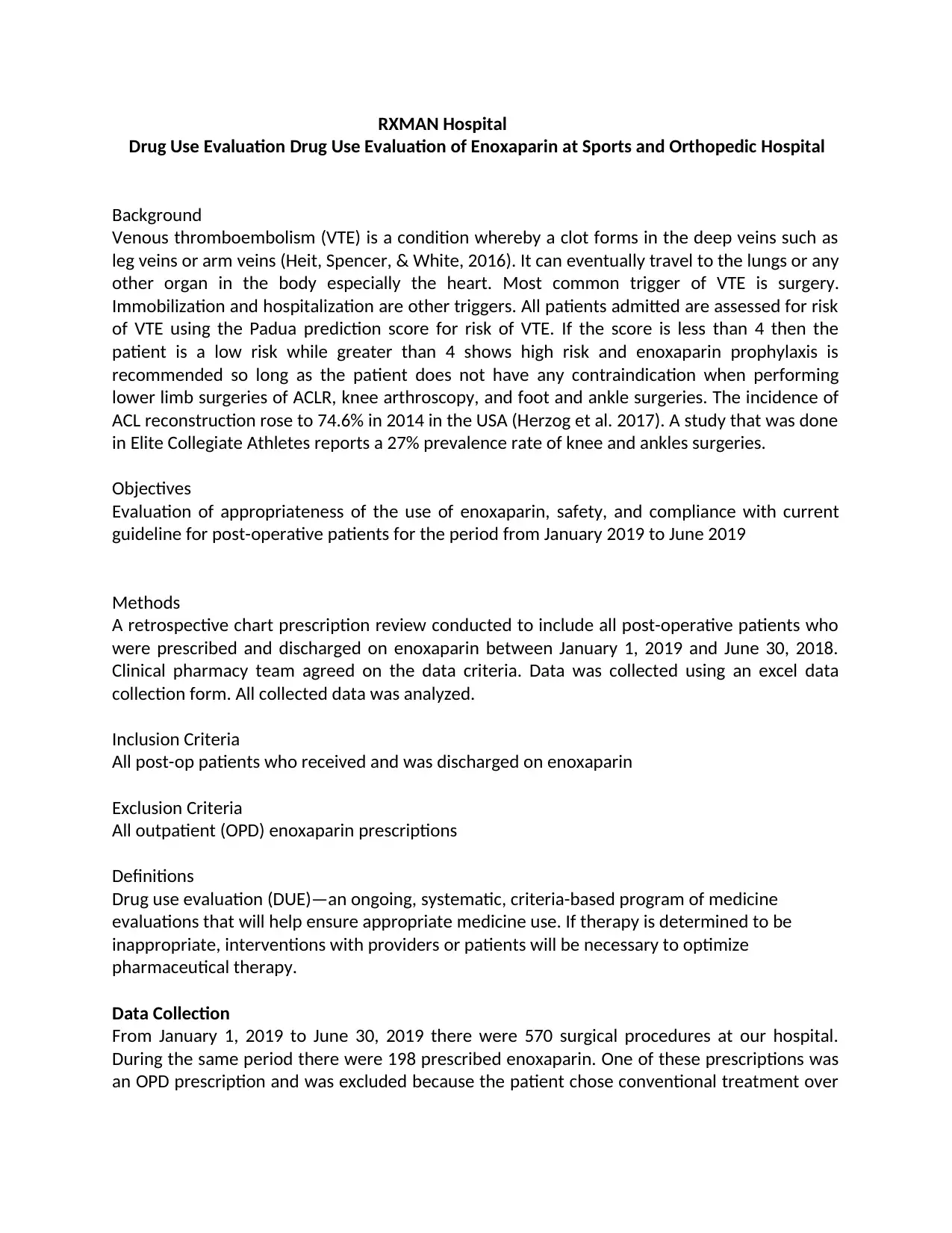
RXMAN Hospital
Drug Use Evaluation Drug Use Evaluation of Enoxaparin at Sports and Orthopedic Hospital
Background
Venous thromboembolism (VTE) is a condition whereby a clot forms in the deep veins such as
leg veins or arm veins (Heit, Spencer, & White, 2016). It can eventually travel to the lungs or any
other organ in the body especially the heart. Most common trigger of VTE is surgery.
Immobilization and hospitalization are other triggers. All patients admitted are assessed for risk
of VTE using the Padua prediction score for risk of VTE. If the score is less than 4 then the
patient is a low risk while greater than 4 shows high risk and enoxaparin prophylaxis is
recommended so long as the patient does not have any contraindication when performing
lower limb surgeries of ACLR, knee arthroscopy, and foot and ankle surgeries. The incidence of
ACL reconstruction rose to 74.6% in 2014 in the USA (Herzog et al. 2017). A study that was done
in Elite Collegiate Athletes reports a 27% prevalence rate of knee and ankles surgeries.
Objectives
Evaluation of appropriateness of the use of enoxaparin, safety, and compliance with current
guideline for post-operative patients for the period from January 2019 to June 2019
Methods
A retrospective chart prescription review conducted to include all post-operative patients who
were prescribed and discharged on enoxaparin between January 1, 2019 and June 30, 2018.
Clinical pharmacy team agreed on the data criteria. Data was collected using an excel data
collection form. All collected data was analyzed.
Inclusion Criteria
All post-op patients who received and was discharged on enoxaparin
Exclusion Criteria
All outpatient (OPD) enoxaparin prescriptions
Definitions
Drug use evaluation (DUE)—an ongoing, systematic, criteria-based program of medicine
evaluations that will help ensure appropriate medicine use. If therapy is determined to be
inappropriate, interventions with providers or patients will be necessary to optimize
pharmaceutical therapy.
Data Collection
From January 1, 2019 to June 30, 2019 there were 570 surgical procedures at our hospital.
During the same period there were 198 prescribed enoxaparin. One of these prescriptions was
an OPD prescription and was excluded because the patient chose conventional treatment over
Drug Use Evaluation Drug Use Evaluation of Enoxaparin at Sports and Orthopedic Hospital
Background
Venous thromboembolism (VTE) is a condition whereby a clot forms in the deep veins such as
leg veins or arm veins (Heit, Spencer, & White, 2016). It can eventually travel to the lungs or any
other organ in the body especially the heart. Most common trigger of VTE is surgery.
Immobilization and hospitalization are other triggers. All patients admitted are assessed for risk
of VTE using the Padua prediction score for risk of VTE. If the score is less than 4 then the
patient is a low risk while greater than 4 shows high risk and enoxaparin prophylaxis is
recommended so long as the patient does not have any contraindication when performing
lower limb surgeries of ACLR, knee arthroscopy, and foot and ankle surgeries. The incidence of
ACL reconstruction rose to 74.6% in 2014 in the USA (Herzog et al. 2017). A study that was done
in Elite Collegiate Athletes reports a 27% prevalence rate of knee and ankles surgeries.
Objectives
Evaluation of appropriateness of the use of enoxaparin, safety, and compliance with current
guideline for post-operative patients for the period from January 2019 to June 2019
Methods
A retrospective chart prescription review conducted to include all post-operative patients who
were prescribed and discharged on enoxaparin between January 1, 2019 and June 30, 2018.
Clinical pharmacy team agreed on the data criteria. Data was collected using an excel data
collection form. All collected data was analyzed.
Inclusion Criteria
All post-op patients who received and was discharged on enoxaparin
Exclusion Criteria
All outpatient (OPD) enoxaparin prescriptions
Definitions
Drug use evaluation (DUE)—an ongoing, systematic, criteria-based program of medicine
evaluations that will help ensure appropriate medicine use. If therapy is determined to be
inappropriate, interventions with providers or patients will be necessary to optimize
pharmaceutical therapy.
Data Collection
From January 1, 2019 to June 30, 2019 there were 570 surgical procedures at our hospital.
During the same period there were 198 prescribed enoxaparin. One of these prescriptions was
an OPD prescription and was excluded because the patient chose conventional treatment over
Secure Best Marks with AI Grader
Need help grading? Try our AI Grader for instant feedback on your assignments.
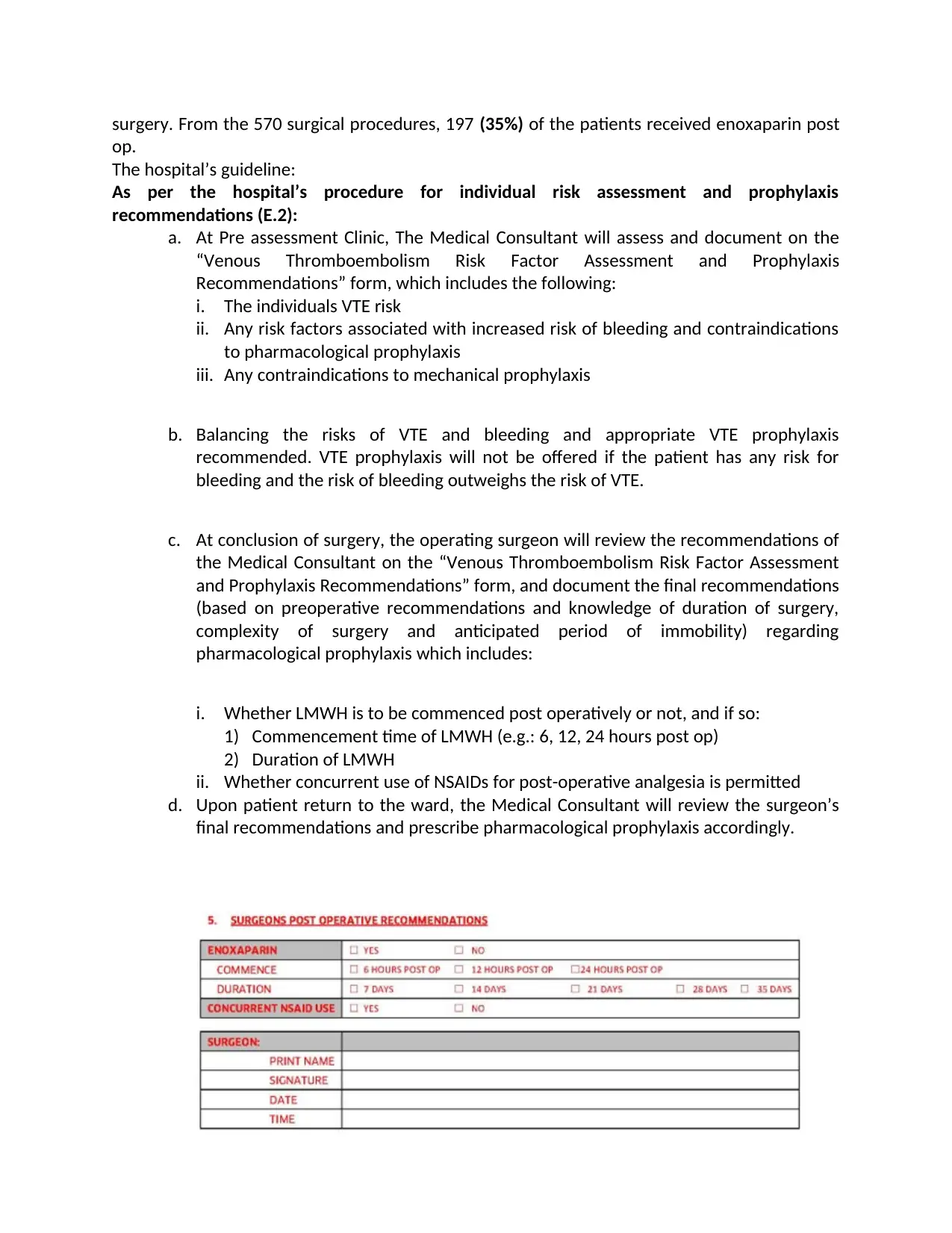
surgery. From the 570 surgical procedures, 197 (35%) of the patients received enoxaparin post
op.
The hospital’s guideline:
As per the hospital’s procedure for individual risk assessment and prophylaxis
recommendations (E.2):
a. At Pre assessment Clinic, The Medical Consultant will assess and document on the
“Venous Thromboembolism Risk Factor Assessment and Prophylaxis
Recommendations” form, which includes the following:
i. The individuals VTE risk
ii. Any risk factors associated with increased risk of bleeding and contraindications
to pharmacological prophylaxis
iii. Any contraindications to mechanical prophylaxis
b. Balancing the risks of VTE and bleeding and appropriate VTE prophylaxis
recommended. VTE prophylaxis will not be offered if the patient has any risk for
bleeding and the risk of bleeding outweighs the risk of VTE.
c. At conclusion of surgery, the operating surgeon will review the recommendations of
the Medical Consultant on the “Venous Thromboembolism Risk Factor Assessment
and Prophylaxis Recommendations” form, and document the final recommendations
(based on preoperative recommendations and knowledge of duration of surgery,
complexity of surgery and anticipated period of immobility) regarding
pharmacological prophylaxis which includes:
i. Whether LMWH is to be commenced post operatively or not, and if so:
1) Commencement time of LMWH (e.g.: 6, 12, 24 hours post op)
2) Duration of LMWH
ii. Whether concurrent use of NSAIDs for post-operative analgesia is permitted
d. Upon patient return to the ward, the Medical Consultant will review the surgeon’s
final recommendations and prescribe pharmacological prophylaxis accordingly.
op.
The hospital’s guideline:
As per the hospital’s procedure for individual risk assessment and prophylaxis
recommendations (E.2):
a. At Pre assessment Clinic, The Medical Consultant will assess and document on the
“Venous Thromboembolism Risk Factor Assessment and Prophylaxis
Recommendations” form, which includes the following:
i. The individuals VTE risk
ii. Any risk factors associated with increased risk of bleeding and contraindications
to pharmacological prophylaxis
iii. Any contraindications to mechanical prophylaxis
b. Balancing the risks of VTE and bleeding and appropriate VTE prophylaxis
recommended. VTE prophylaxis will not be offered if the patient has any risk for
bleeding and the risk of bleeding outweighs the risk of VTE.
c. At conclusion of surgery, the operating surgeon will review the recommendations of
the Medical Consultant on the “Venous Thromboembolism Risk Factor Assessment
and Prophylaxis Recommendations” form, and document the final recommendations
(based on preoperative recommendations and knowledge of duration of surgery,
complexity of surgery and anticipated period of immobility) regarding
pharmacological prophylaxis which includes:
i. Whether LMWH is to be commenced post operatively or not, and if so:
1) Commencement time of LMWH (e.g.: 6, 12, 24 hours post op)
2) Duration of LMWH
ii. Whether concurrent use of NSAIDs for post-operative analgesia is permitted
d. Upon patient return to the ward, the Medical Consultant will review the surgeon’s
final recommendations and prescribe pharmacological prophylaxis accordingly.
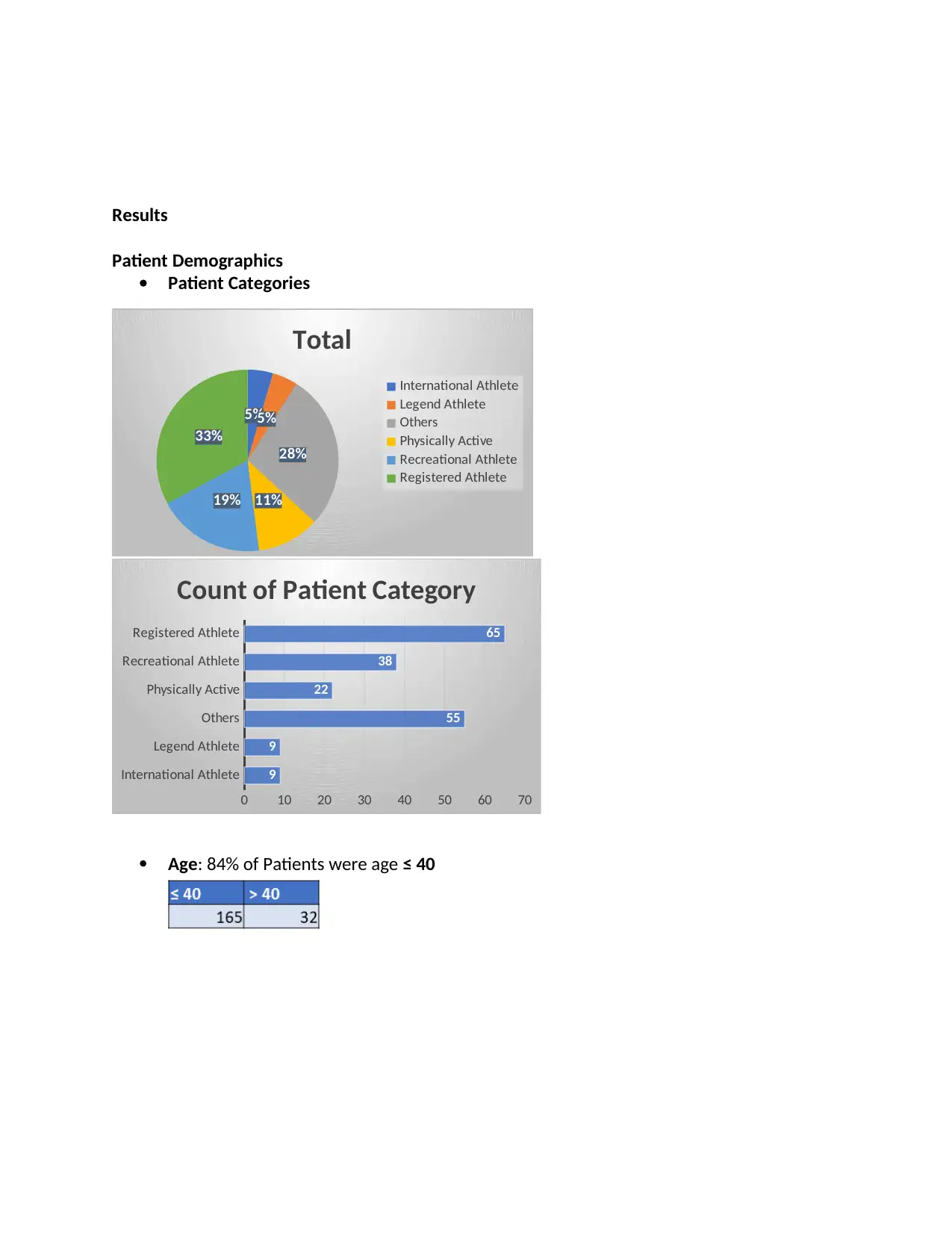
Results
Patient Demographics
Patient Categories
5%5%
28%
11%19%
33%
Total
International Athlete
Legend Athlete
Others
Physically Active
Recreational Athlete
Registered Athlete
International Athlete
Legend Athlete
Others
Physically Active
Recreational Athlete
Registered Athlete
0 10 20 30 40 50 60 70
9
9
55
22
38
65
Count of Patient Category
Age: 84% of Patients were age ≤ 40
Patient Demographics
Patient Categories
5%5%
28%
11%19%
33%
Total
International Athlete
Legend Athlete
Others
Physically Active
Recreational Athlete
Registered Athlete
International Athlete
Legend Athlete
Others
Physically Active
Recreational Athlete
Registered Athlete
0 10 20 30 40 50 60 70
9
9
55
22
38
65
Count of Patient Category
Age: 84% of Patients were age ≤ 40
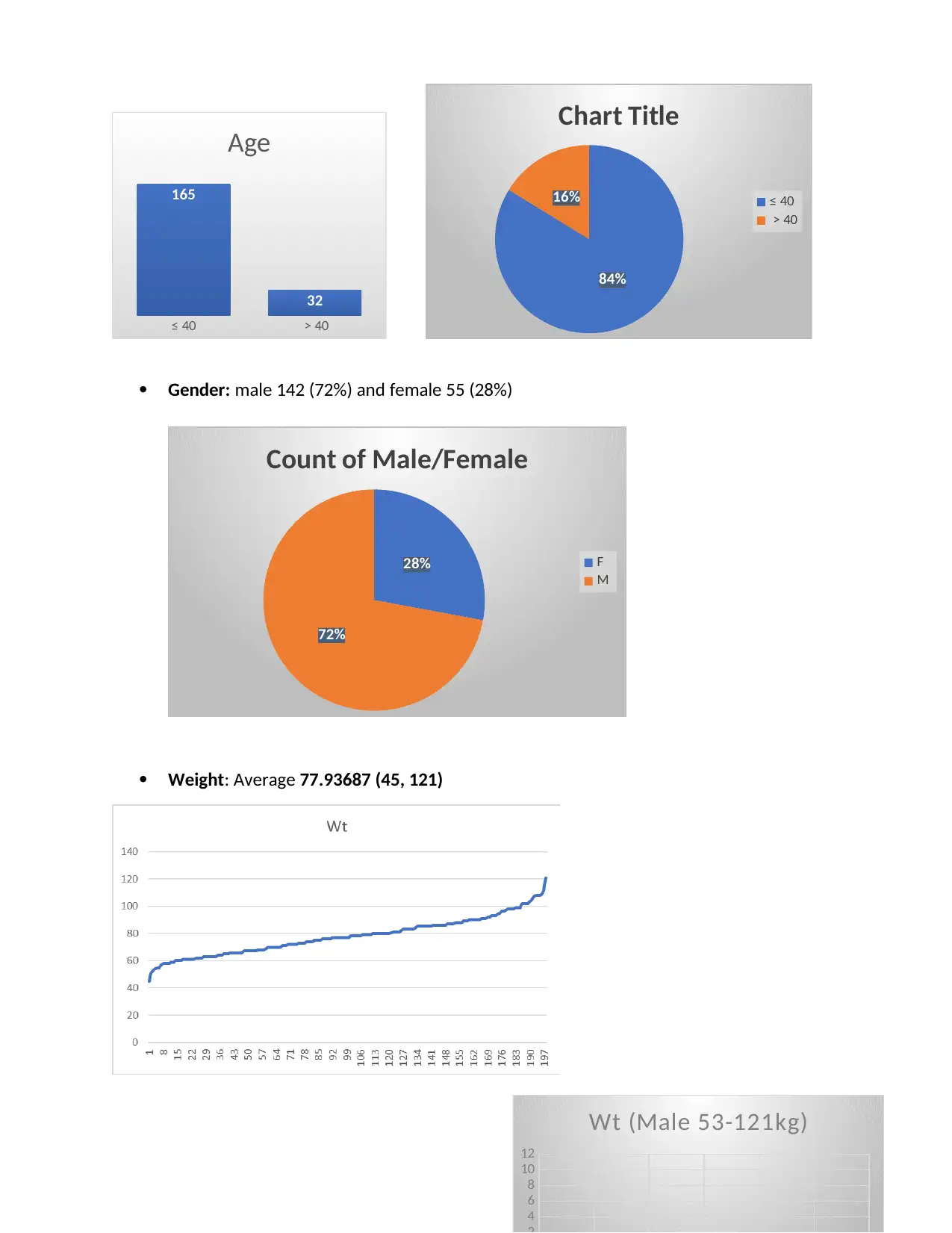
≤ 40 > 40
165
32
Age
Gender: male 142 (72%) and female 55 (28%)
28%
72%
Count of Male/Female
F
M
Weight: Average 77.93687 (45, 121)
4
6
8
10
12
Wt (Male 53-121kg)
84%
16%
Chart Title
≤ 40
> 40
165
32
Age
Gender: male 142 (72%) and female 55 (28%)
28%
72%
Count of Male/Female
F
M
Weight: Average 77.93687 (45, 121)
4
6
8
10
12
Wt (Male 53-121kg)
84%
16%
Chart Title
≤ 40
> 40
Secure Best Marks with AI Grader
Need help grading? Try our AI Grader for instant feedback on your assignments.
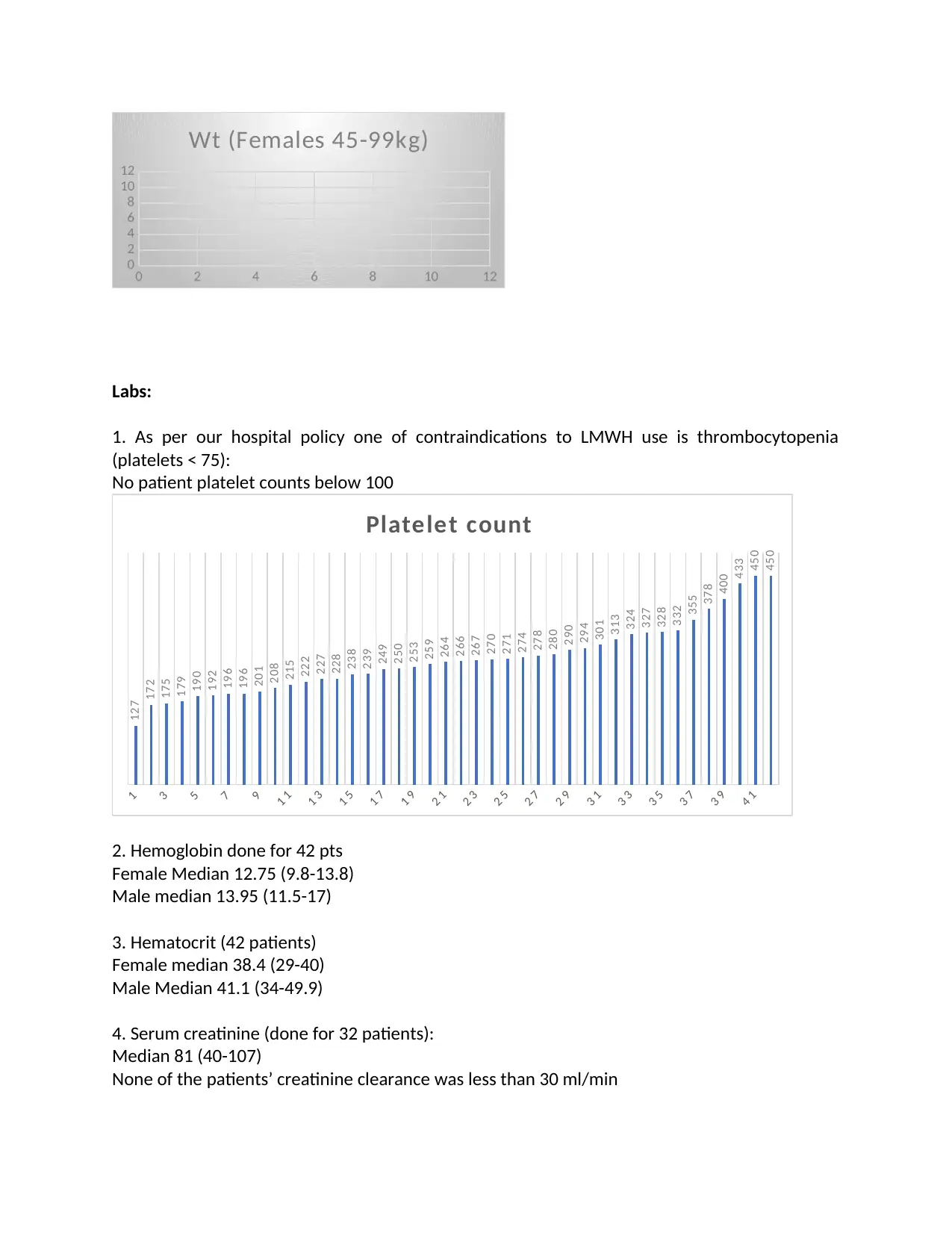
0 2 4 6 8 10 12
0
2
4
6
8
10
12
Wt (Females 45-99kg)
Labs:
1. As per our hospital policy one of contraindications to LMWH use is thrombocytopenia
(platelets < 75):
No patient platelet counts below 100
1
3
5
7
9
1 1
1 3
1 5
1 7
1 9
2 1
2 3
2 5
2 7
2 9
3 1
3 3
3 5
3 7
3 9
4 1
127
172
175
179
190
192
196
196
201
208
215
222
227
228
238
239
249
250
253
259
264
266
267
270
271
274
278
280
290
294
301
313
324
327
328
332
355
378
400
433
450
450
Platelet count
2. Hemoglobin done for 42 pts
Female Median 12.75 (9.8-13.8)
Male median 13.95 (11.5-17)
3. Hematocrit (42 patients)
Female median 38.4 (29-40)
Male Median 41.1 (34-49.9)
4. Serum creatinine (done for 32 patients):
Median 81 (40-107)
None of the patients’ creatinine clearance was less than 30 ml/min
0 2 4 6 8 10 12
0
2
4
6
8
10
12
Wt (Females 45-99kg)
Labs:
1. As per our hospital policy one of contraindications to LMWH use is thrombocytopenia
(platelets < 75):
No patient platelet counts below 100
1
3
5
7
9
1 1
1 3
1 5
1 7
1 9
2 1
2 3
2 5
2 7
2 9
3 1
3 3
3 5
3 7
3 9
4 1
127
172
175
179
190
192
196
196
201
208
215
222
227
228
238
239
249
250
253
259
264
266
267
270
271
274
278
280
290
294
301
313
324
327
328
332
355
378
400
433
450
450
Platelet count
2. Hemoglobin done for 42 pts
Female Median 12.75 (9.8-13.8)
Male median 13.95 (11.5-17)
3. Hematocrit (42 patients)
Female median 38.4 (29-40)
Male Median 41.1 (34-49.9)
4. Serum creatinine (done for 32 patients):
Median 81 (40-107)
None of the patients’ creatinine clearance was less than 30 ml/min
0 2 4 6 8 10 12
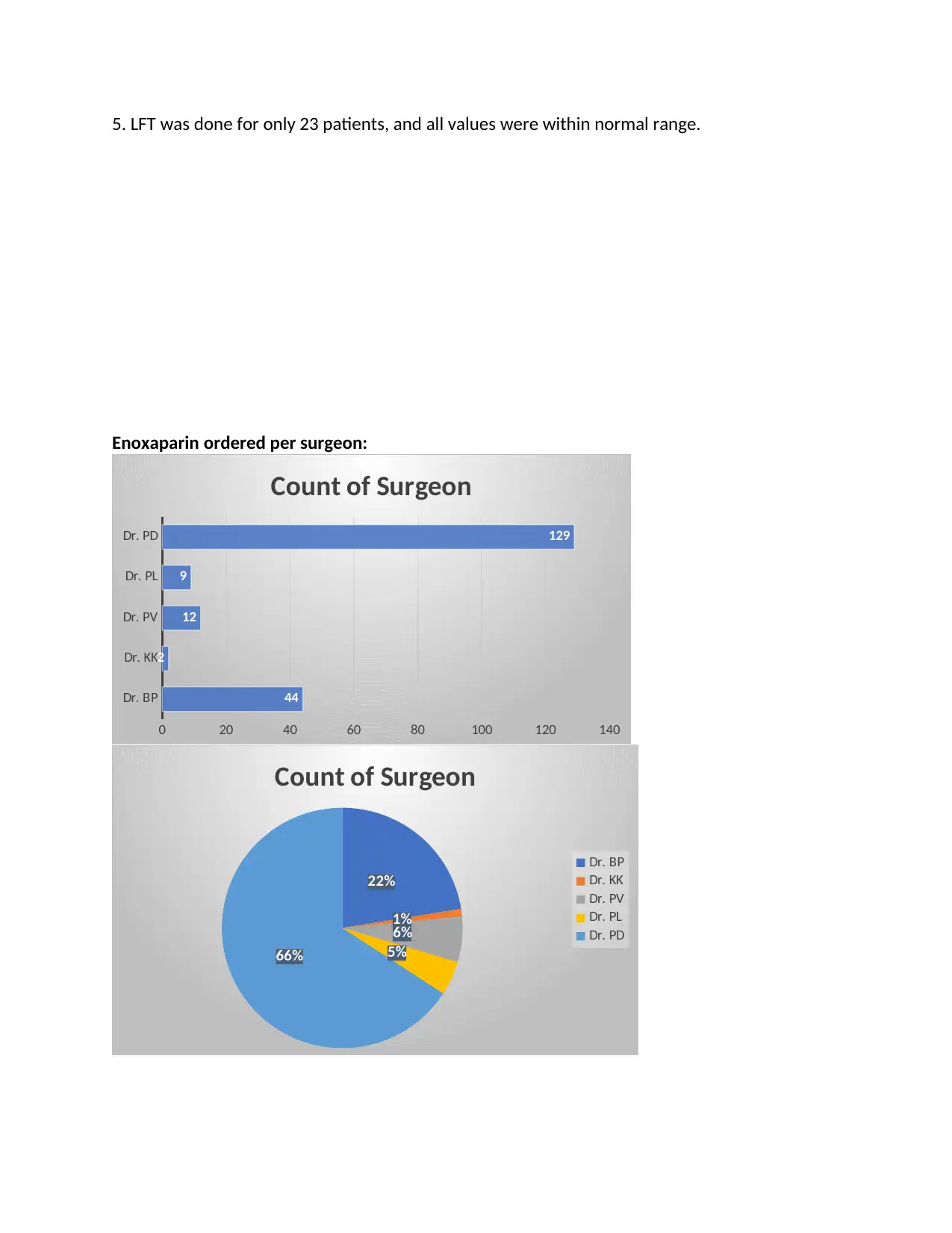
5. LFT was done for only 23 patients, and all values were within normal range.
Enoxaparin ordered per surgeon:
Dr. BP
Dr. KK
Dr. PV
Dr. PL
Dr. PD
0 20 40 60 80 100 120 140
44
2
12
9
129
Count of Surgeon
22%
1%
6%
5%66%
Count of Surgeon
Dr. BP
Dr. KK
Dr. PV
Dr. PL
Dr. PD
Enoxaparin ordered per surgeon:
Dr. BP
Dr. KK
Dr. PV
Dr. PL
Dr. PD
0 20 40 60 80 100 120 140
44
2
12
9
129
Count of Surgeon
22%
1%
6%
5%66%
Count of Surgeon
Dr. BP
Dr. KK
Dr. PV
Dr. PL
Dr. PD
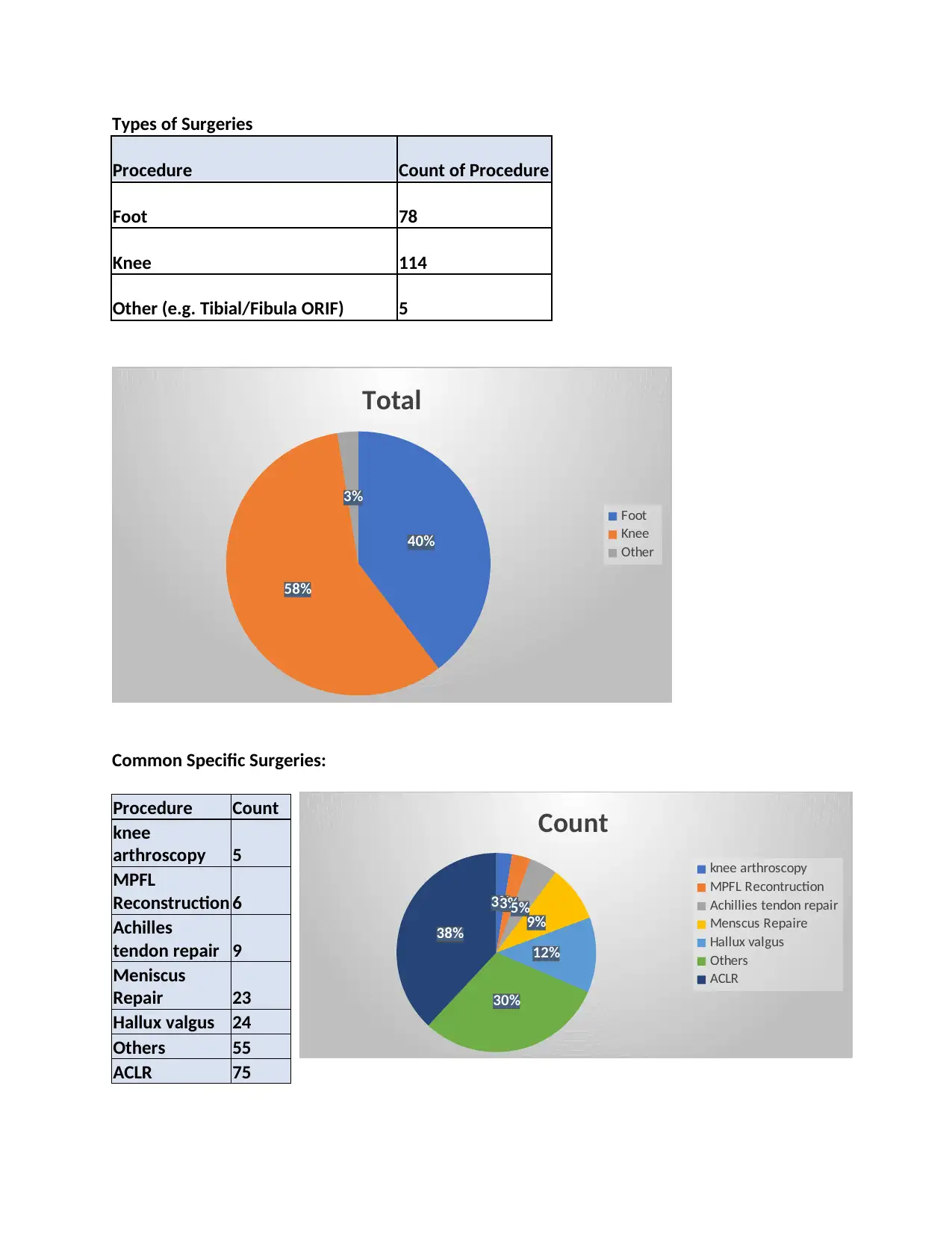
Types of Surgeries
Procedure Count of Procedure
Foot 78
Knee 114
Other (e.g. Tibial/Fibula ORIF) 5
40%
58%
3%
Total
Foot
Knee
Other
Common Specific Surgeries:
Procedure Count
knee
arthroscopy 5
MPFL
Reconstruction 6
Achilles
tendon repair 9
Meniscus
Repair 23
Hallux valgus 24
Others 55
ACLR 75
3%3%5%
9%
12%
30%
38%
Count
knee arthroscopy
MPFL Recontruction
Achillies tendon repair
Menscus Repaire
Hallux valgus
Others
ACLR
Procedure Count of Procedure
Foot 78
Knee 114
Other (e.g. Tibial/Fibula ORIF) 5
40%
58%
3%
Total
Foot
Knee
Other
Common Specific Surgeries:
Procedure Count
knee
arthroscopy 5
MPFL
Reconstruction 6
Achilles
tendon repair 9
Meniscus
Repair 23
Hallux valgus 24
Others 55
ACLR 75
3%3%5%
9%
12%
30%
38%
Count
knee arthroscopy
MPFL Recontruction
Achillies tendon repair
Menscus Repaire
Hallux valgus
Others
ACLR
Paraphrase This Document
Need a fresh take? Get an instant paraphrase of this document with our AI Paraphraser
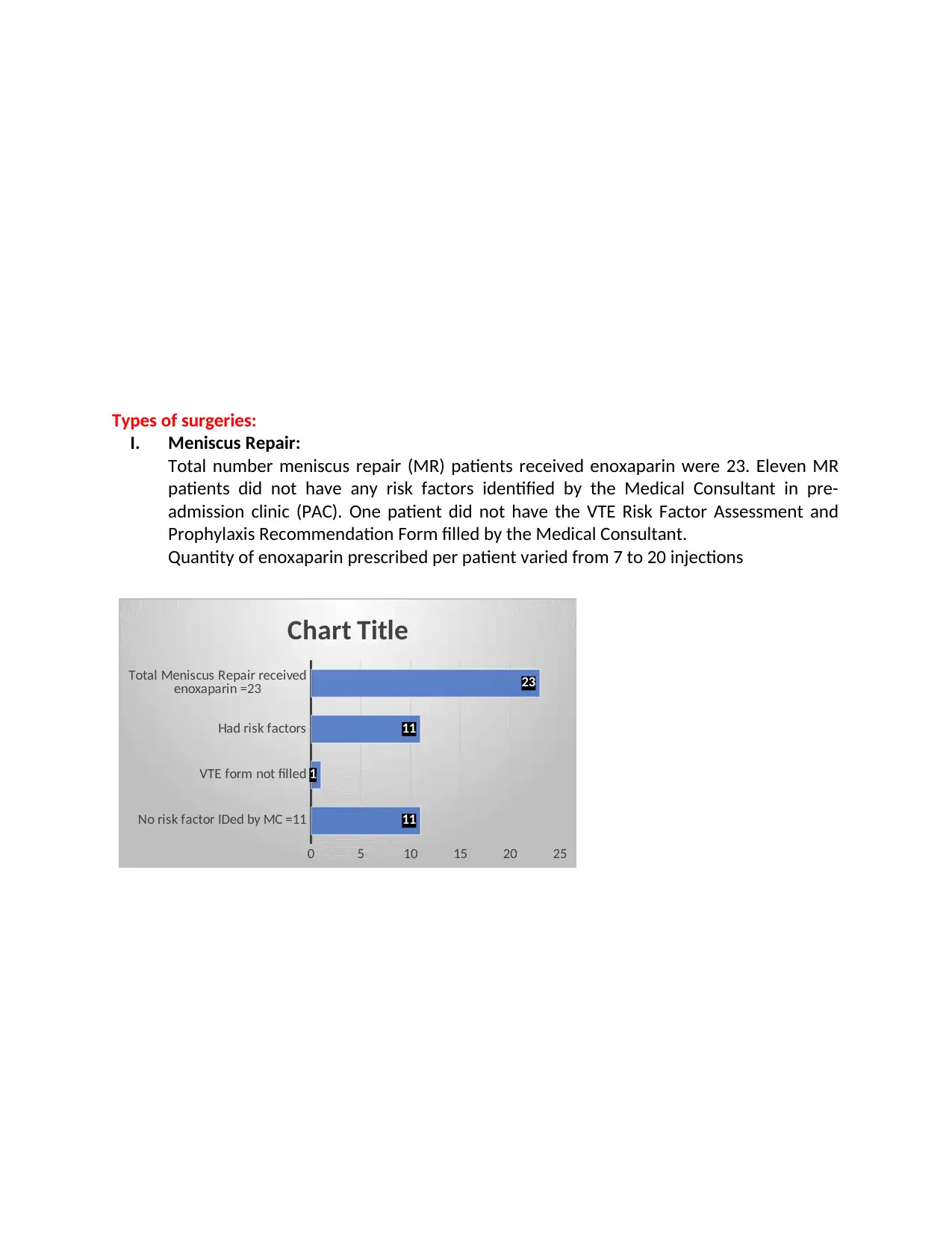
Types of surgeries:
I. Meniscus Repair:
Total number meniscus repair (MR) patients received enoxaparin were 23. Eleven MR
patients did not have any risk factors identified by the Medical Consultant in pre-
admission clinic (PAC). One patient did not have the VTE Risk Factor Assessment and
Prophylaxis Recommendation Form filled by the Medical Consultant.
Quantity of enoxaparin prescribed per patient varied from 7 to 20 injections
No risk factor IDed by MC =11
VTE form not filled
Had risk factors
Total Meniscus Repair received
enoxaparin =23
0 5 10 15 20 25
11
1
11
23
Chart Title
I. Meniscus Repair:
Total number meniscus repair (MR) patients received enoxaparin were 23. Eleven MR
patients did not have any risk factors identified by the Medical Consultant in pre-
admission clinic (PAC). One patient did not have the VTE Risk Factor Assessment and
Prophylaxis Recommendation Form filled by the Medical Consultant.
Quantity of enoxaparin prescribed per patient varied from 7 to 20 injections
No risk factor IDed by MC =11
VTE form not filled
Had risk factors
Total Meniscus Repair received
enoxaparin =23
0 5 10 15 20 25
11
1
11
23
Chart Title

Meniscus repair
Meniscus repair
Meniscus repair
Meniscus repair
Meniscus repair
Meniscus repair
Meniscus repair
Meniscus repair
Meniscus repair
Meniscus repair
Meniscus repair
Meniscus repair
7 7 7 7 7 7 7 7 7 7 7 7 7 7 7 7 7 7 7 7
14
20 20
Quantity of enoxaparin Prescribed
II. Ankle and Foot surgeries:
Total number of foot/ankle surgery patients who received enoxaparin was 78.
o Two of the patients did not have any risk factors Identified by the Medical
Consultant in pre-admission clinic (PAC).
All patients had the VTE Risk Factor Assessment and Prophylaxis Recommendation Form
filled by the Medical Consultant.
Quantity of enoxaparin prescribed for each patient varied from 7 to 28 days.
Foot/Ankle 78 total
No risk factor IDed by MC
VTE form not filled
0 10 20 30 40 50 60 70 80 90
78
2
0
Count
T ot a l M e nisc us
R e pa ir r e c e ive d
e nox a pa r in = 23
No r isk fa c t or I D e d
by MC = 11
23
11
Risk factors
Meniscus repair
Meniscus repair
Meniscus repair
Meniscus repair
Meniscus repair
Meniscus repair
Meniscus repair
Meniscus repair
Meniscus repair
Meniscus repair
Meniscus repair
7 7 7 7 7 7 7 7 7 7 7 7 7 7 7 7 7 7 7 7
14
20 20
Quantity of enoxaparin Prescribed
II. Ankle and Foot surgeries:
Total number of foot/ankle surgery patients who received enoxaparin was 78.
o Two of the patients did not have any risk factors Identified by the Medical
Consultant in pre-admission clinic (PAC).
All patients had the VTE Risk Factor Assessment and Prophylaxis Recommendation Form
filled by the Medical Consultant.
Quantity of enoxaparin prescribed for each patient varied from 7 to 28 days.
Foot/Ankle 78 total
No risk factor IDed by MC
VTE form not filled
0 10 20 30 40 50 60 70 80 90
78
2
0
Count
T ot a l M e nisc us
R e pa ir r e c e ive d
e nox a pa r in = 23
No r isk fa c t or I D e d
by MC = 11
23
11
Risk factors

Seven days Fourteen days Twenty one days Twenty eight days
25.00
28.00
22.00
3.00
Number of Pts Vs Qty prescribed
III. ACLR
Total number of ACLR surgery patients who received enoxaparin were 75. All the
patients had risk factors Identified by the Medical Consultant in pre-admission clinic
(PAC).
Three patients did not have the VTE Risk Factor Assessment and Prophylaxis
Recommendation Form filled by the Medical Consultant.
Quantity of enoxaparin prescribed for each patient varied from 3 to 28 days
Three Seven Ten Fourteen Twenty Twenty
one Twenty
eight
1
22
1
9
4
37
1
Qunatity Prescribed
The Dose:
195 patients received enoxaparin 40 mg, only two patients received 20 mg doseof enoxaparin
and no laboratory testing was done for both patients.
1. First patient male 17y/o, wt 53 ACLR, surgical & anesthetic time > 60 minutes total for
surgery of pelvis or lower limb, expected significant reduction in mobility. Discussed
with MC regarding the 20 mg dose of enoxaparin daily. He prefers the patient to have
20 mg daily because of patient's age, weight and the patient is on ibuprofen. 14 days of
enoxaparin prescribed.
2. 2nd patient is female 40 y/o, weight 51 kg. For ACLR. Surgical & Anesthetic time > 60
minutes total for surgery of pelvis or lower limb, expected significant reduction in
25.00
28.00
22.00
3.00
Number of Pts Vs Qty prescribed
III. ACLR
Total number of ACLR surgery patients who received enoxaparin were 75. All the
patients had risk factors Identified by the Medical Consultant in pre-admission clinic
(PAC).
Three patients did not have the VTE Risk Factor Assessment and Prophylaxis
Recommendation Form filled by the Medical Consultant.
Quantity of enoxaparin prescribed for each patient varied from 3 to 28 days
Three Seven Ten Fourteen Twenty Twenty
one Twenty
eight
1
22
1
9
4
37
1
Qunatity Prescribed
The Dose:
195 patients received enoxaparin 40 mg, only two patients received 20 mg doseof enoxaparin
and no laboratory testing was done for both patients.
1. First patient male 17y/o, wt 53 ACLR, surgical & anesthetic time > 60 minutes total for
surgery of pelvis or lower limb, expected significant reduction in mobility. Discussed
with MC regarding the 20 mg dose of enoxaparin daily. He prefers the patient to have
20 mg daily because of patient's age, weight and the patient is on ibuprofen. 14 days of
enoxaparin prescribed.
2. 2nd patient is female 40 y/o, weight 51 kg. For ACLR. Surgical & Anesthetic time > 60
minutes total for surgery of pelvis or lower limb, expected significant reduction in
Secure Best Marks with AI Grader
Need help grading? Try our AI Grader for instant feedback on your assignments.

mobility. Surgeon request Surgeon request with no explanation provided. & days of
enoxaparin 20 mg prescribed.
40 mg 20 mg
195
299% 1%
• The limitation of this data is that it did not capture the patients who were
recommended enoxaparin by the medical consultant in the PAC, but the surgeon did not
order enoxaparin after the surgery.
• None of the patients who received enoxaparin were upper limbs surgeries as per the
guideline’s recommendations, 100% of the surgeries were lower limb.
• Any patient on anticoagulant or antiplatelet therapies?
• No patient from the collected data was on any anticoagulant or antiplatelet
medications from home.
• Any Contraindications to pharmacological prophylaxis for VTE?
• None
• One Asthmatic ACLR patient with Aspirin-induced asthma, the surgeon ordered aspirin.
Clinical pharmacist called the surgeon and suggested changing the aspirin to enoxaparin.
The surgeon agreed to change it to enoxaparin.
Risk factors:
1. VTE Risk Factor Assessment findings:
a. Surgical & Anesthetic time > 60 minutes total for surgery of pelvis or lower limb,
Expected significant reduction in mobility: 117 patients (59%)
b. Age > 40, Surgical & Anesthetic time > 60 minutes total for surgery of pelvis or
lower limb, Expected significant reduction in mobility: 19 patients (10%)
c. Surgical & Anesthetic time > 60 minutes total for surgery of pelvis or lower limb,
Expected significant reduction in mobility Obesity (BMI >30): 15 patients (8%)
d. NO VTE RISK FACTORS identified by the Medical Consultant, but received
enoxaparin: 16 patients (8.1%)
e. Four patients (2%) the VTE form was not filled by the Medical Consultant
enoxaparin 20 mg prescribed.
40 mg 20 mg
195
299% 1%
• The limitation of this data is that it did not capture the patients who were
recommended enoxaparin by the medical consultant in the PAC, but the surgeon did not
order enoxaparin after the surgery.
• None of the patients who received enoxaparin were upper limbs surgeries as per the
guideline’s recommendations, 100% of the surgeries were lower limb.
• Any patient on anticoagulant or antiplatelet therapies?
• No patient from the collected data was on any anticoagulant or antiplatelet
medications from home.
• Any Contraindications to pharmacological prophylaxis for VTE?
• None
• One Asthmatic ACLR patient with Aspirin-induced asthma, the surgeon ordered aspirin.
Clinical pharmacist called the surgeon and suggested changing the aspirin to enoxaparin.
The surgeon agreed to change it to enoxaparin.
Risk factors:
1. VTE Risk Factor Assessment findings:
a. Surgical & Anesthetic time > 60 minutes total for surgery of pelvis or lower limb,
Expected significant reduction in mobility: 117 patients (59%)
b. Age > 40, Surgical & Anesthetic time > 60 minutes total for surgery of pelvis or
lower limb, Expected significant reduction in mobility: 19 patients (10%)
c. Surgical & Anesthetic time > 60 minutes total for surgery of pelvis or lower limb,
Expected significant reduction in mobility Obesity (BMI >30): 15 patients (8%)
d. NO VTE RISK FACTORS identified by the Medical Consultant, but received
enoxaparin: 16 patients (8.1%)
e. Four patients (2%) the VTE form was not filled by the Medical Consultant

f. 180 pts had risk factor identified by MC: 92% compliance
g. 193 VTE form were filled: 98% Compliance
VTE form not filled
VTE form filled
Total
0 50 100 150 200 250
4
192
196
Count
Any Risk Factors with increased risk of bleeding?
No patient in the collected data had any risk factors with increased risk of bleeding.
g. 193 VTE form were filled: 98% Compliance
VTE form not filled
VTE form filled
Total
0 50 100 150 200 250
4
192
196
Count
Any Risk Factors with increased risk of bleeding?
No patient in the collected data had any risk factors with increased risk of bleeding.

Adverse drug reaction (ADR)
Two patient had ADR
• One patient experienced hematoma and swelling knee. Enoxaparin was discontinued
and the condition was resolved. The surgeon discontinued it on the 9th day post-
surgery. It was prescribed for 21days
• Second patient had facial swelling and redness after the first dose. This was treated
with Desloratadine. There was quick resolution of symptoms. It was prescribed for 7
days. Discontinued after first dose.
Drug Interactions
Other than with NSAIDs: No
Summary of the findings:
1. Efficacy
I. None of the 197 patients had any reported VTEs post-surgery.
II. 195 patients received enoxaparin 40 mg, only two patients received 20 mg dose
no lab was done for either patient
i. First patient male 17y/o, wt 53 ACLR, surgical & anesthetic time > 60
minutes total for surgery of pelvis or lower limb, Expected significant
reduction in mobility. Discussed with MC regarding the 20 mg dose of
enoxaparin daily. He prefers the patient to have 20 mg daily because of
patient's age, weight and the patient is on ibuprofen. 14 days of
enoxaparin prescribed.
ii. 2nd patient is female 40 y/o, weight 51 kg. For ACLR. Surgical &
Anesthetic time > 60 minutes total for surgery of pelvis or lower limb,
expected significant reduction in mobility. Surgeon request Surgeon
Two patient had ADR
• One patient experienced hematoma and swelling knee. Enoxaparin was discontinued
and the condition was resolved. The surgeon discontinued it on the 9th day post-
surgery. It was prescribed for 21days
• Second patient had facial swelling and redness after the first dose. This was treated
with Desloratadine. There was quick resolution of symptoms. It was prescribed for 7
days. Discontinued after first dose.
Drug Interactions
Other than with NSAIDs: No
Summary of the findings:
1. Efficacy
I. None of the 197 patients had any reported VTEs post-surgery.
II. 195 patients received enoxaparin 40 mg, only two patients received 20 mg dose
no lab was done for either patient
i. First patient male 17y/o, wt 53 ACLR, surgical & anesthetic time > 60
minutes total for surgery of pelvis or lower limb, Expected significant
reduction in mobility. Discussed with MC regarding the 20 mg dose of
enoxaparin daily. He prefers the patient to have 20 mg daily because of
patient's age, weight and the patient is on ibuprofen. 14 days of
enoxaparin prescribed.
ii. 2nd patient is female 40 y/o, weight 51 kg. For ACLR. Surgical &
Anesthetic time > 60 minutes total for surgery of pelvis or lower limb,
expected significant reduction in mobility. Surgeon request Surgeon
Paraphrase This Document
Need a fresh take? Get an instant paraphrase of this document with our AI Paraphraser
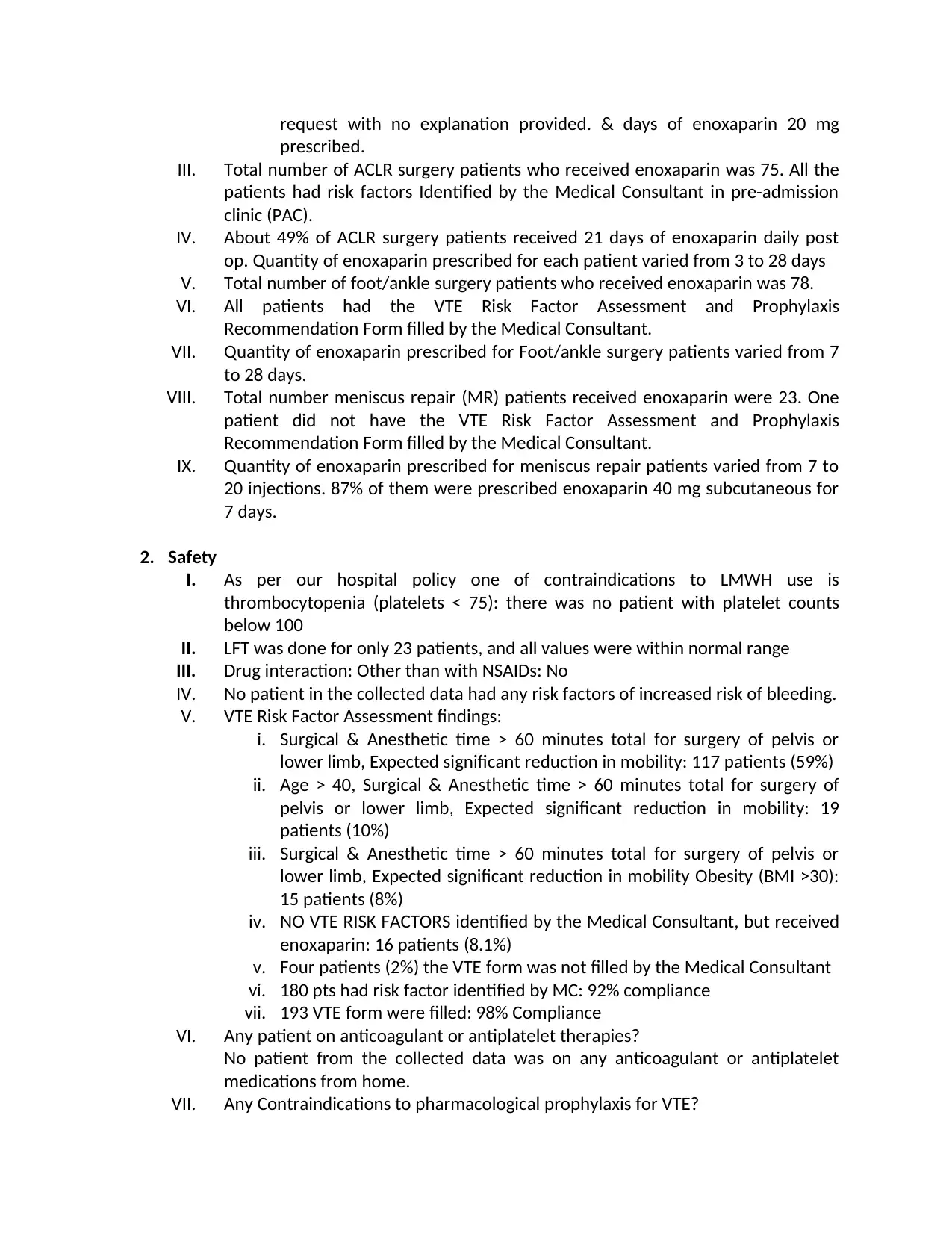
request with no explanation provided. & days of enoxaparin 20 mg
prescribed.
III. Total number of ACLR surgery patients who received enoxaparin was 75. All the
patients had risk factors Identified by the Medical Consultant in pre-admission
clinic (PAC).
IV. About 49% of ACLR surgery patients received 21 days of enoxaparin daily post
op. Quantity of enoxaparin prescribed for each patient varied from 3 to 28 days
V. Total number of foot/ankle surgery patients who received enoxaparin was 78.
VI. All patients had the VTE Risk Factor Assessment and Prophylaxis
Recommendation Form filled by the Medical Consultant.
VII. Quantity of enoxaparin prescribed for Foot/ankle surgery patients varied from 7
to 28 days.
VIII. Total number meniscus repair (MR) patients received enoxaparin were 23. One
patient did not have the VTE Risk Factor Assessment and Prophylaxis
Recommendation Form filled by the Medical Consultant.
IX. Quantity of enoxaparin prescribed for meniscus repair patients varied from 7 to
20 injections. 87% of them were prescribed enoxaparin 40 mg subcutaneous for
7 days.
2. Safety
I. As per our hospital policy one of contraindications to LMWH use is
thrombocytopenia (platelets < 75): there was no patient with platelet counts
below 100
II. LFT was done for only 23 patients, and all values were within normal range
III. Drug interaction: Other than with NSAIDs: No
IV. No patient in the collected data had any risk factors of increased risk of bleeding.
V. VTE Risk Factor Assessment findings:
i. Surgical & Anesthetic time > 60 minutes total for surgery of pelvis or
lower limb, Expected significant reduction in mobility: 117 patients (59%)
ii. Age > 40, Surgical & Anesthetic time > 60 minutes total for surgery of
pelvis or lower limb, Expected significant reduction in mobility: 19
patients (10%)
iii. Surgical & Anesthetic time > 60 minutes total for surgery of pelvis or
lower limb, Expected significant reduction in mobility Obesity (BMI >30):
15 patients (8%)
iv. NO VTE RISK FACTORS identified by the Medical Consultant, but received
enoxaparin: 16 patients (8.1%)
v. Four patients (2%) the VTE form was not filled by the Medical Consultant
vi. 180 pts had risk factor identified by MC: 92% compliance
vii. 193 VTE form were filled: 98% Compliance
VI. Any patient on anticoagulant or antiplatelet therapies?
No patient from the collected data was on any anticoagulant or antiplatelet
medications from home.
VII. Any Contraindications to pharmacological prophylaxis for VTE?
prescribed.
III. Total number of ACLR surgery patients who received enoxaparin was 75. All the
patients had risk factors Identified by the Medical Consultant in pre-admission
clinic (PAC).
IV. About 49% of ACLR surgery patients received 21 days of enoxaparin daily post
op. Quantity of enoxaparin prescribed for each patient varied from 3 to 28 days
V. Total number of foot/ankle surgery patients who received enoxaparin was 78.
VI. All patients had the VTE Risk Factor Assessment and Prophylaxis
Recommendation Form filled by the Medical Consultant.
VII. Quantity of enoxaparin prescribed for Foot/ankle surgery patients varied from 7
to 28 days.
VIII. Total number meniscus repair (MR) patients received enoxaparin were 23. One
patient did not have the VTE Risk Factor Assessment and Prophylaxis
Recommendation Form filled by the Medical Consultant.
IX. Quantity of enoxaparin prescribed for meniscus repair patients varied from 7 to
20 injections. 87% of them were prescribed enoxaparin 40 mg subcutaneous for
7 days.
2. Safety
I. As per our hospital policy one of contraindications to LMWH use is
thrombocytopenia (platelets < 75): there was no patient with platelet counts
below 100
II. LFT was done for only 23 patients, and all values were within normal range
III. Drug interaction: Other than with NSAIDs: No
IV. No patient in the collected data had any risk factors of increased risk of bleeding.
V. VTE Risk Factor Assessment findings:
i. Surgical & Anesthetic time > 60 minutes total for surgery of pelvis or
lower limb, Expected significant reduction in mobility: 117 patients (59%)
ii. Age > 40, Surgical & Anesthetic time > 60 minutes total for surgery of
pelvis or lower limb, Expected significant reduction in mobility: 19
patients (10%)
iii. Surgical & Anesthetic time > 60 minutes total for surgery of pelvis or
lower limb, Expected significant reduction in mobility Obesity (BMI >30):
15 patients (8%)
iv. NO VTE RISK FACTORS identified by the Medical Consultant, but received
enoxaparin: 16 patients (8.1%)
v. Four patients (2%) the VTE form was not filled by the Medical Consultant
vi. 180 pts had risk factor identified by MC: 92% compliance
vii. 193 VTE form were filled: 98% Compliance
VI. Any patient on anticoagulant or antiplatelet therapies?
No patient from the collected data was on any anticoagulant or antiplatelet
medications from home.
VII. Any Contraindications to pharmacological prophylaxis for VTE?
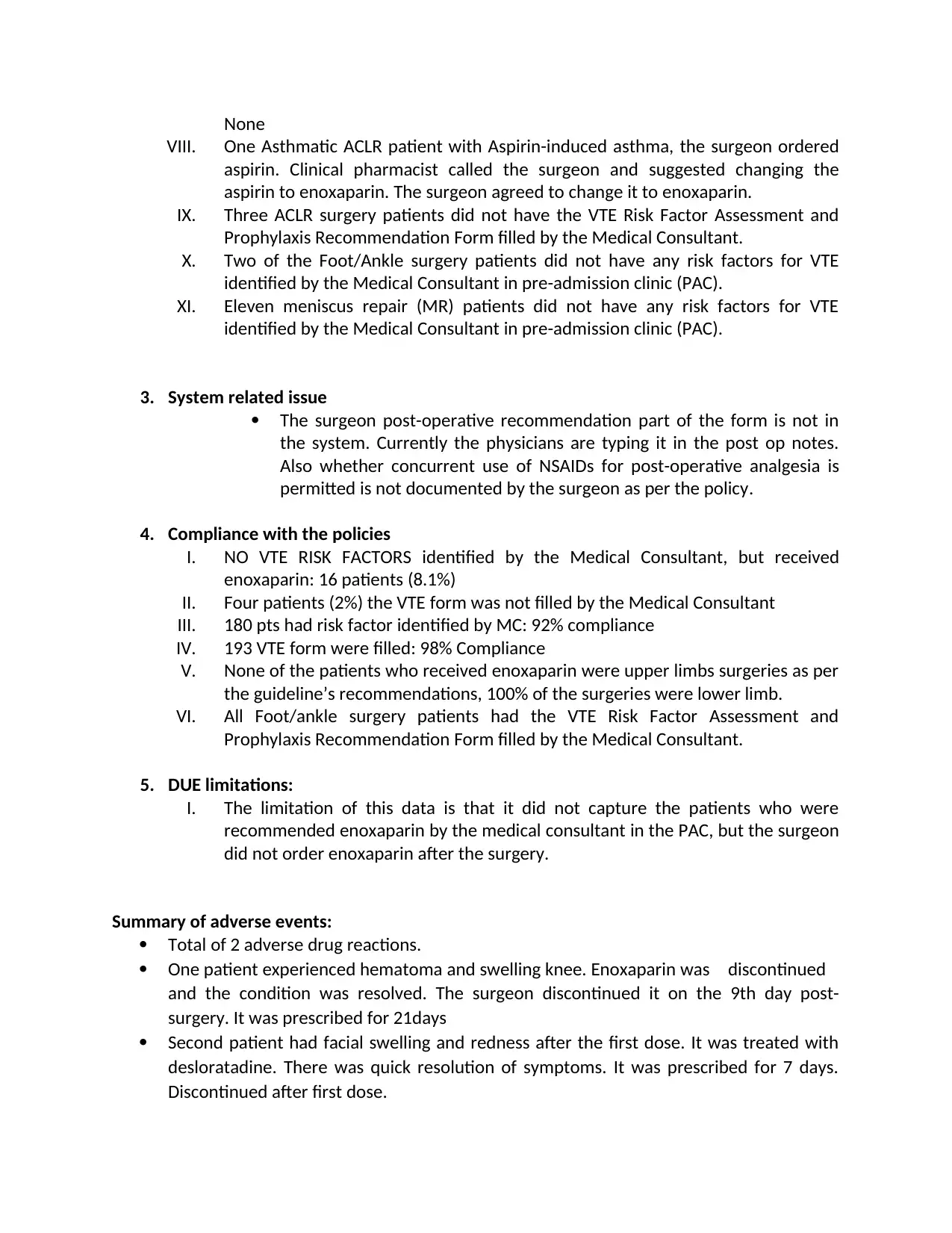
None
VIII. One Asthmatic ACLR patient with Aspirin-induced asthma, the surgeon ordered
aspirin. Clinical pharmacist called the surgeon and suggested changing the
aspirin to enoxaparin. The surgeon agreed to change it to enoxaparin.
IX. Three ACLR surgery patients did not have the VTE Risk Factor Assessment and
Prophylaxis Recommendation Form filled by the Medical Consultant.
X. Two of the Foot/Ankle surgery patients did not have any risk factors for VTE
identified by the Medical Consultant in pre-admission clinic (PAC).
XI. Eleven meniscus repair (MR) patients did not have any risk factors for VTE
identified by the Medical Consultant in pre-admission clinic (PAC).
3. System related issue
The surgeon post-operative recommendation part of the form is not in
the system. Currently the physicians are typing it in the post op notes.
Also whether concurrent use of NSAIDs for post-operative analgesia is
permitted is not documented by the surgeon as per the policy.
4. Compliance with the policies
I. NO VTE RISK FACTORS identified by the Medical Consultant, but received
enoxaparin: 16 patients (8.1%)
II. Four patients (2%) the VTE form was not filled by the Medical Consultant
III. 180 pts had risk factor identified by MC: 92% compliance
IV. 193 VTE form were filled: 98% Compliance
V. None of the patients who received enoxaparin were upper limbs surgeries as per
the guideline’s recommendations, 100% of the surgeries were lower limb.
VI. All Foot/ankle surgery patients had the VTE Risk Factor Assessment and
Prophylaxis Recommendation Form filled by the Medical Consultant.
5. DUE limitations:
I. The limitation of this data is that it did not capture the patients who were
recommended enoxaparin by the medical consultant in the PAC, but the surgeon
did not order enoxaparin after the surgery.
Summary of adverse events:
Total of 2 adverse drug reactions.
One patient experienced hematoma and swelling knee. Enoxaparin was discontinued
and the condition was resolved. The surgeon discontinued it on the 9th day post-
surgery. It was prescribed for 21days
Second patient had facial swelling and redness after the first dose. It was treated with
desloratadine. There was quick resolution of symptoms. It was prescribed for 7 days.
Discontinued after first dose.
VIII. One Asthmatic ACLR patient with Aspirin-induced asthma, the surgeon ordered
aspirin. Clinical pharmacist called the surgeon and suggested changing the
aspirin to enoxaparin. The surgeon agreed to change it to enoxaparin.
IX. Three ACLR surgery patients did not have the VTE Risk Factor Assessment and
Prophylaxis Recommendation Form filled by the Medical Consultant.
X. Two of the Foot/Ankle surgery patients did not have any risk factors for VTE
identified by the Medical Consultant in pre-admission clinic (PAC).
XI. Eleven meniscus repair (MR) patients did not have any risk factors for VTE
identified by the Medical Consultant in pre-admission clinic (PAC).
3. System related issue
The surgeon post-operative recommendation part of the form is not in
the system. Currently the physicians are typing it in the post op notes.
Also whether concurrent use of NSAIDs for post-operative analgesia is
permitted is not documented by the surgeon as per the policy.
4. Compliance with the policies
I. NO VTE RISK FACTORS identified by the Medical Consultant, but received
enoxaparin: 16 patients (8.1%)
II. Four patients (2%) the VTE form was not filled by the Medical Consultant
III. 180 pts had risk factor identified by MC: 92% compliance
IV. 193 VTE form were filled: 98% Compliance
V. None of the patients who received enoxaparin were upper limbs surgeries as per
the guideline’s recommendations, 100% of the surgeries were lower limb.
VI. All Foot/ankle surgery patients had the VTE Risk Factor Assessment and
Prophylaxis Recommendation Form filled by the Medical Consultant.
5. DUE limitations:
I. The limitation of this data is that it did not capture the patients who were
recommended enoxaparin by the medical consultant in the PAC, but the surgeon
did not order enoxaparin after the surgery.
Summary of adverse events:
Total of 2 adverse drug reactions.
One patient experienced hematoma and swelling knee. Enoxaparin was discontinued
and the condition was resolved. The surgeon discontinued it on the 9th day post-
surgery. It was prescribed for 21days
Second patient had facial swelling and redness after the first dose. It was treated with
desloratadine. There was quick resolution of symptoms. It was prescribed for 7 days.
Discontinued after first dose.
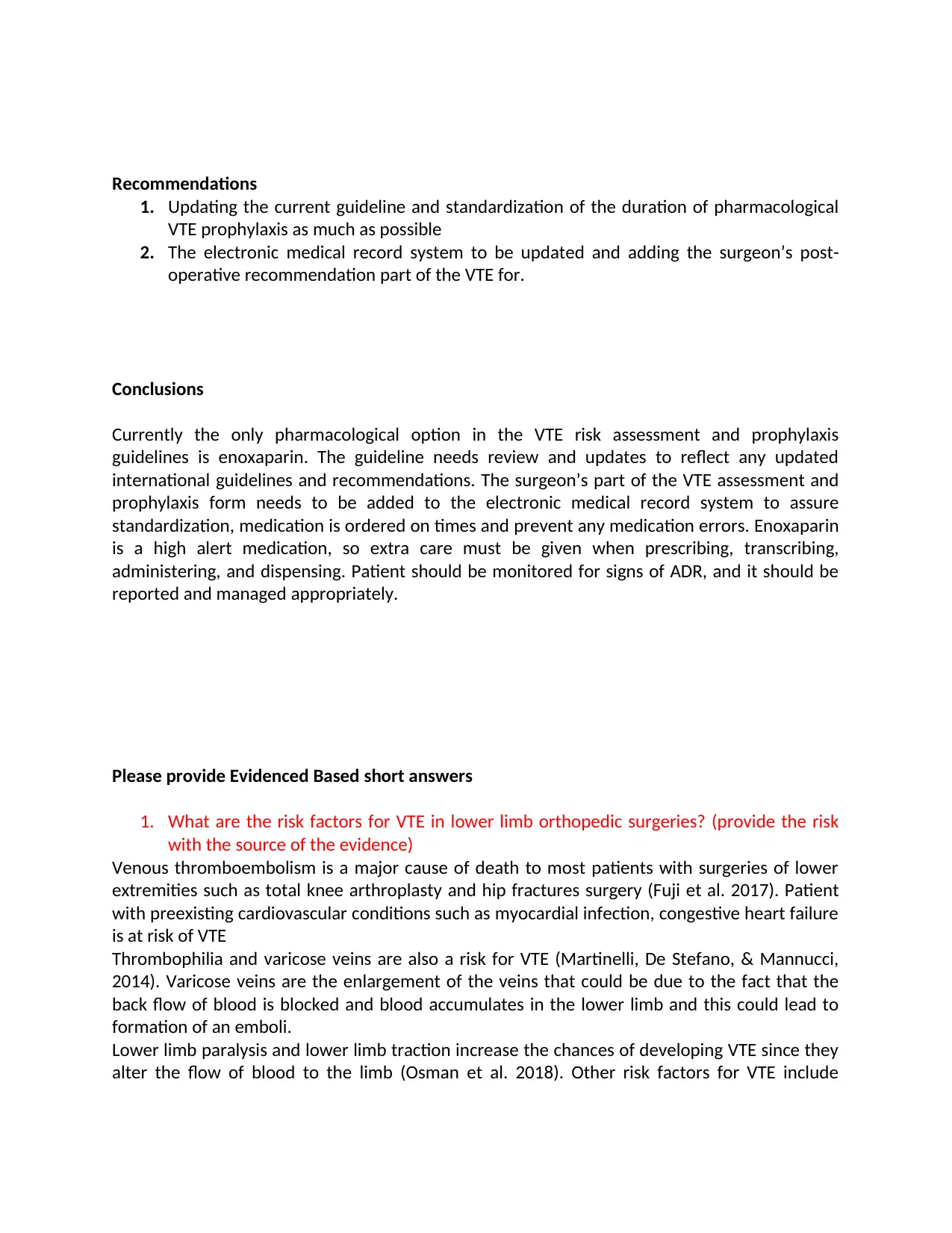
Recommendations
1. Updating the current guideline and standardization of the duration of pharmacological
VTE prophylaxis as much as possible
2. The electronic medical record system to be updated and adding the surgeon’s post-
operative recommendation part of the VTE for.
Conclusions
Currently the only pharmacological option in the VTE risk assessment and prophylaxis
guidelines is enoxaparin. The guideline needs review and updates to reflect any updated
international guidelines and recommendations. The surgeon’s part of the VTE assessment and
prophylaxis form needs to be added to the electronic medical record system to assure
standardization, medication is ordered on times and prevent any medication errors. Enoxaparin
is a high alert medication, so extra care must be given when prescribing, transcribing,
administering, and dispensing. Patient should be monitored for signs of ADR, and it should be
reported and managed appropriately.
Please provide Evidenced Based short answers
1. What are the risk factors for VTE in lower limb orthopedic surgeries? (provide the risk
with the source of the evidence)
Venous thromboembolism is a major cause of death to most patients with surgeries of lower
extremities such as total knee arthroplasty and hip fractures surgery (Fuji et al. 2017). Patient
with preexisting cardiovascular conditions such as myocardial infection, congestive heart failure
is at risk of VTE
Thrombophilia and varicose veins are also a risk for VTE (Martinelli, De Stefano, & Mannucci,
2014). Varicose veins are the enlargement of the veins that could be due to the fact that the
back flow of blood is blocked and blood accumulates in the lower limb and this could lead to
formation of an emboli.
Lower limb paralysis and lower limb traction increase the chances of developing VTE since they
alter the flow of blood to the limb (Osman et al. 2018). Other risk factors for VTE include
1. Updating the current guideline and standardization of the duration of pharmacological
VTE prophylaxis as much as possible
2. The electronic medical record system to be updated and adding the surgeon’s post-
operative recommendation part of the VTE for.
Conclusions
Currently the only pharmacological option in the VTE risk assessment and prophylaxis
guidelines is enoxaparin. The guideline needs review and updates to reflect any updated
international guidelines and recommendations. The surgeon’s part of the VTE assessment and
prophylaxis form needs to be added to the electronic medical record system to assure
standardization, medication is ordered on times and prevent any medication errors. Enoxaparin
is a high alert medication, so extra care must be given when prescribing, transcribing,
administering, and dispensing. Patient should be monitored for signs of ADR, and it should be
reported and managed appropriately.
Please provide Evidenced Based short answers
1. What are the risk factors for VTE in lower limb orthopedic surgeries? (provide the risk
with the source of the evidence)
Venous thromboembolism is a major cause of death to most patients with surgeries of lower
extremities such as total knee arthroplasty and hip fractures surgery (Fuji et al. 2017). Patient
with preexisting cardiovascular conditions such as myocardial infection, congestive heart failure
is at risk of VTE
Thrombophilia and varicose veins are also a risk for VTE (Martinelli, De Stefano, & Mannucci,
2014). Varicose veins are the enlargement of the veins that could be due to the fact that the
back flow of blood is blocked and blood accumulates in the lower limb and this could lead to
formation of an emboli.
Lower limb paralysis and lower limb traction increase the chances of developing VTE since they
alter the flow of blood to the limb (Osman et al. 2018). Other risk factors for VTE include
Secure Best Marks with AI Grader
Need help grading? Try our AI Grader for instant feedback on your assignments.

malignant disease, obesity since excess fat accumulates in the blood vessels and hence
interfere with blood flow thus causing VTE (Lerstad, 2017).
2. What are the risk factors associated with increased risk of bleeding or contraindications
to pharmacological VTE prophylaxis? (provide the contraindications with the source of
the evidence)
Use of VTE prophylaxis is contraindicated incase a patient has a risk of bleeding or has active
bleeding such as gastrointestinal, cerebral or retroperitoneal bleeding (Ahmed et al. 2018).
In cases of thrombocytopenia also prophylaxis are not recommended since they might increase
chances of bleeding (Flevas et al. 2018).
3. Is pharmacological VTE prophylaxis (e.g. enoxaparin) is recommended for post -op
Meniscus Repair surgeries patients, especially if there is no risk of significant
reeducation in mobility and patient can tolerate full weight bearing?
Use of enoxaparin in meniscus repair is used to prevent VTE (Fang et al. 2018) but one
needs to monitor for any peripheral edema or incase the patient has underlying
conditions such as kidney insufficiency or are obese.
4. What is the place of low molecular weight heparin (LMWH) for VTE prophylaxis in
current studies and guideline and compare to emerging studies of PO medications like
Aspirin?
LMWH is a widely used anticoagulant due to its efficacy, practical advantages (Ciccone
et al. 2014). It has a better anticoagulant effect compared to warfarin and doesn’t
require frequent laboratory monitoring (Barnes et al. 2017). More so it has a longer half-
life and a lower incidence of heparin induced thrombocytopenia (Greinacher,
Warkentin, & Chong, 2019). However, the guidelines stipulate that a clinician needs to
consider certain factors before prescribing the LMWH such as patients health needs,
patient demographics (Stewart, 2014). However according to CPGs recommendation,
they do not recommend use of LMWH in the post-operative prophylaxis of VTE in
patients undergoing hip or knee surgeries who cannot use warfarin (Shah et al. 2016).
5. What is the recommended dose, frequency, duration of therapy, and the start time
post operatively for enoxaparin injection for each of the following surgeries in high risk
patients?
a. ACLR surgeries Dose:2.5mg twice a day
Start time: within 12 to 24 hrs
post-operative.
Continue for 35 days
b. Knee arthroscopy Dose:30 mg subcutaneously twice
a day
Within 12-24 hours post
operatively
Continue for 7 to 10 days
c. Foot/ankle surgeries Dose:05 mg/kg subcutaneously
twice a day.
interfere with blood flow thus causing VTE (Lerstad, 2017).
2. What are the risk factors associated with increased risk of bleeding or contraindications
to pharmacological VTE prophylaxis? (provide the contraindications with the source of
the evidence)
Use of VTE prophylaxis is contraindicated incase a patient has a risk of bleeding or has active
bleeding such as gastrointestinal, cerebral or retroperitoneal bleeding (Ahmed et al. 2018).
In cases of thrombocytopenia also prophylaxis are not recommended since they might increase
chances of bleeding (Flevas et al. 2018).
3. Is pharmacological VTE prophylaxis (e.g. enoxaparin) is recommended for post -op
Meniscus Repair surgeries patients, especially if there is no risk of significant
reeducation in mobility and patient can tolerate full weight bearing?
Use of enoxaparin in meniscus repair is used to prevent VTE (Fang et al. 2018) but one
needs to monitor for any peripheral edema or incase the patient has underlying
conditions such as kidney insufficiency or are obese.
4. What is the place of low molecular weight heparin (LMWH) for VTE prophylaxis in
current studies and guideline and compare to emerging studies of PO medications like
Aspirin?
LMWH is a widely used anticoagulant due to its efficacy, practical advantages (Ciccone
et al. 2014). It has a better anticoagulant effect compared to warfarin and doesn’t
require frequent laboratory monitoring (Barnes et al. 2017). More so it has a longer half-
life and a lower incidence of heparin induced thrombocytopenia (Greinacher,
Warkentin, & Chong, 2019). However, the guidelines stipulate that a clinician needs to
consider certain factors before prescribing the LMWH such as patients health needs,
patient demographics (Stewart, 2014). However according to CPGs recommendation,
they do not recommend use of LMWH in the post-operative prophylaxis of VTE in
patients undergoing hip or knee surgeries who cannot use warfarin (Shah et al. 2016).
5. What is the recommended dose, frequency, duration of therapy, and the start time
post operatively for enoxaparin injection for each of the following surgeries in high risk
patients?
a. ACLR surgeries Dose:2.5mg twice a day
Start time: within 12 to 24 hrs
post-operative.
Continue for 35 days
b. Knee arthroscopy Dose:30 mg subcutaneously twice
a day
Within 12-24 hours post
operatively
Continue for 7 to 10 days
c. Foot/ankle surgeries Dose:05 mg/kg subcutaneously
twice a day.
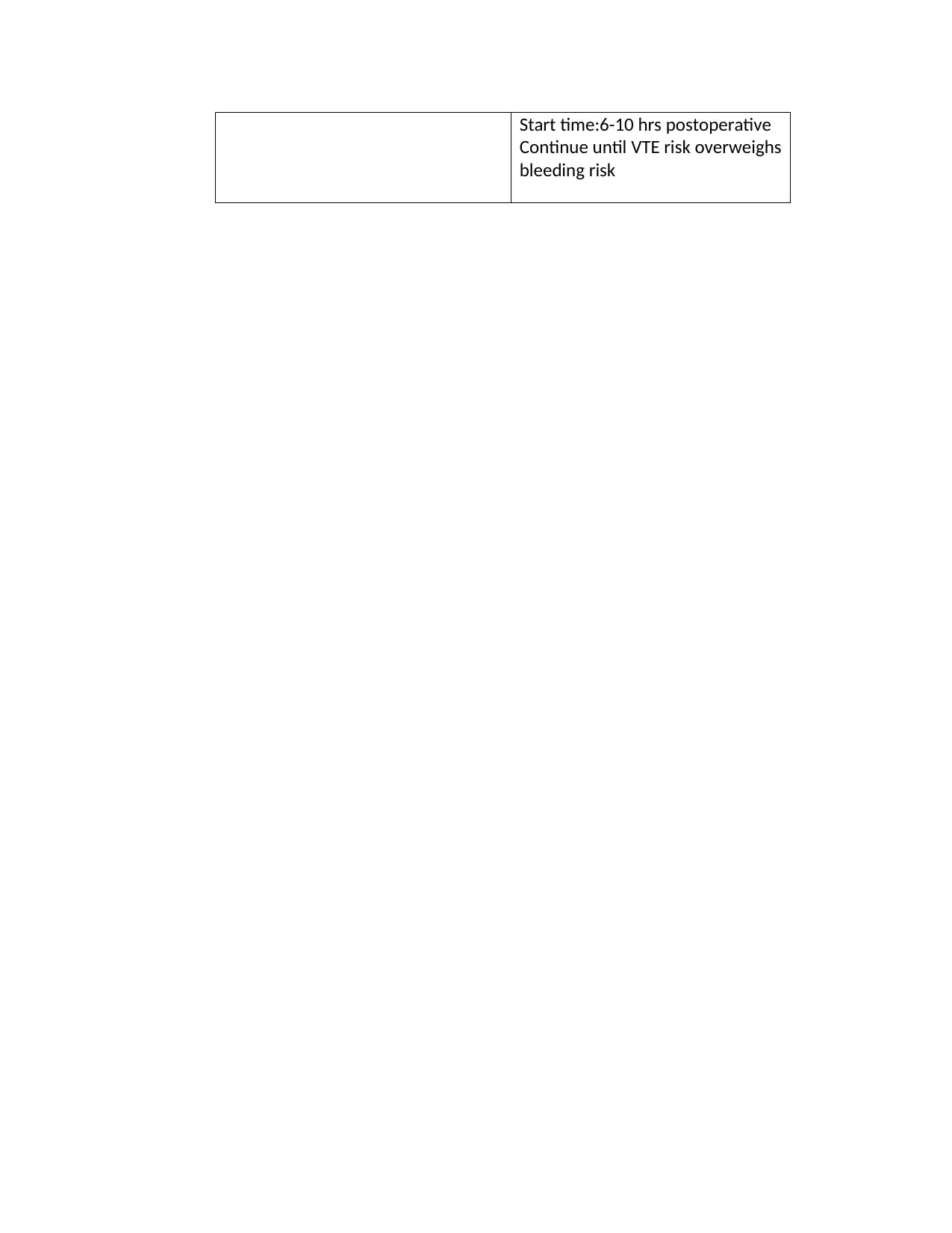
Start time:6-10 hrs postoperative
Continue until VTE risk overweighs
bleeding risk
Continue until VTE risk overweighs
bleeding risk

References
Ahmed, A., Kozek-Langenecker, S., Mullier, F., Pavord, S., & Hermans, C. (2018). European
guidelines on perioperative venous thromboembolism prophylaxis: Patients with
preexisting coagulation disorders and after severe perioperative bleeding. European
Journal of Anaesthesiology (EJA), 35(2), 96-107.
Barnes, G. D., Misirliyan, S., Kaatz, S., Jackson, E. A., Haymart, B., Kline-Rogers, E., ... & Sales, A. (2017).
Barriers and facilitators to reducing frequent laboratory testing for patients who are stable on
warfarin: a mixed methods study of de-implementation in five anticoagulation
clinics. Implementation Science, 12(1), 87.
Ciccone, M. M., Cortese, F., Corbo, F., Corrales, N. E., Al-Momen, A. K., Silva, A., ... &
Scicchitano, P. (2014). Bemiparin, an effective and safe low molecular weight heparin: a
review. Vascular pharmacology, 62(1), 32-37.
Fang, C. H., Liu, H., Zhang, J. H., & Yan, S. G. (2018). An unusual case of symptomatic deep vein
thrombosis and pulmonary embolism after arthroscopic meniscus surgery. BMC
musculoskeletal disorders, 19(1), 19.
Flevas, D. A., Megaloikonomos, P. D., Dimopoulos, L., Mitsiokapa, E., Koulouvaris, P., &
Mavrogenis, A. F. (2018). Thromboembolism prophylaxis in orthopaedics: an
update. EFORT open reviews, 3(4), 136-148.
Fuji, T., Akagi, M., Abe, Y., Oda, E., Matsubayashi, D., Ota, K., ... & Takita, A. (2017). Incidence of
venous thromboembolism and bleeding events in patients with lower extremity
orthopedic surgery: a retrospective analysis of a Japanese healthcare database. Journal
of orthopaedic surgery and research, 12(1), 55.
Greinacher, A., Warkentin, T. E., & Chong, B. H. (2019). Heparin-induced thrombocytopenia.
In Platelets (pp. 741-767). Academic Press.
Ahmed, A., Kozek-Langenecker, S., Mullier, F., Pavord, S., & Hermans, C. (2018). European
guidelines on perioperative venous thromboembolism prophylaxis: Patients with
preexisting coagulation disorders and after severe perioperative bleeding. European
Journal of Anaesthesiology (EJA), 35(2), 96-107.
Barnes, G. D., Misirliyan, S., Kaatz, S., Jackson, E. A., Haymart, B., Kline-Rogers, E., ... & Sales, A. (2017).
Barriers and facilitators to reducing frequent laboratory testing for patients who are stable on
warfarin: a mixed methods study of de-implementation in five anticoagulation
clinics. Implementation Science, 12(1), 87.
Ciccone, M. M., Cortese, F., Corbo, F., Corrales, N. E., Al-Momen, A. K., Silva, A., ... &
Scicchitano, P. (2014). Bemiparin, an effective and safe low molecular weight heparin: a
review. Vascular pharmacology, 62(1), 32-37.
Fang, C. H., Liu, H., Zhang, J. H., & Yan, S. G. (2018). An unusual case of symptomatic deep vein
thrombosis and pulmonary embolism after arthroscopic meniscus surgery. BMC
musculoskeletal disorders, 19(1), 19.
Flevas, D. A., Megaloikonomos, P. D., Dimopoulos, L., Mitsiokapa, E., Koulouvaris, P., &
Mavrogenis, A. F. (2018). Thromboembolism prophylaxis in orthopaedics: an
update. EFORT open reviews, 3(4), 136-148.
Fuji, T., Akagi, M., Abe, Y., Oda, E., Matsubayashi, D., Ota, K., ... & Takita, A. (2017). Incidence of
venous thromboembolism and bleeding events in patients with lower extremity
orthopedic surgery: a retrospective analysis of a Japanese healthcare database. Journal
of orthopaedic surgery and research, 12(1), 55.
Greinacher, A., Warkentin, T. E., & Chong, B. H. (2019). Heparin-induced thrombocytopenia.
In Platelets (pp. 741-767). Academic Press.
Paraphrase This Document
Need a fresh take? Get an instant paraphrase of this document with our AI Paraphraser

Heit, J. A., Spencer, F. A., & White, R. H. (2016). The epidemiology of venous thromboembolism. Journal
of thrombosis and thrombolysis, 41(1), 3-14.
Herzog, M. M., Marshall, S. W., Lund, J. L., Pate, V., Mack, C. D., & Spang, J. T. (2017). Incidence of
anterior cruciate ligament reconstruction among adolescent females in the United States, 2002
through 2014. JAMA pediatrics, 171(8), 808-810.
Lerstad, G. (2017). Endocrine-related factors and risk of venous thromboembolism.
Martinelli, I., De Stefano, V., & Mannucci, P. M. (2014). Inherited risk factors for venous
thromboembolism. Nature Reviews Cardiology, 11(3), 140.
Osman, A. A., Ju, W., Sun, D., & Qi, B. (2018). Deep venous thrombosis: a literature review. Int J
Clin Exp Med, 11(3), 1551-61.
Shah, S. S., Satin, A. M., Mullen, J. R., Merwin, S., Goldin, M., & Sgaglione, N. A. (2016). Impact
of recent guideline changes on aspirin prescribing after knee arthroplasty. Journal of
orthopaedic surgery and research, 11(1), 123.
Stewart, D. W. (2014). Prescribing of low-molecular-weight heparin and warfarin in patients
with acute venous thromboembolism and active cancer.
of thrombosis and thrombolysis, 41(1), 3-14.
Herzog, M. M., Marshall, S. W., Lund, J. L., Pate, V., Mack, C. D., & Spang, J. T. (2017). Incidence of
anterior cruciate ligament reconstruction among adolescent females in the United States, 2002
through 2014. JAMA pediatrics, 171(8), 808-810.
Lerstad, G. (2017). Endocrine-related factors and risk of venous thromboembolism.
Martinelli, I., De Stefano, V., & Mannucci, P. M. (2014). Inherited risk factors for venous
thromboembolism. Nature Reviews Cardiology, 11(3), 140.
Osman, A. A., Ju, W., Sun, D., & Qi, B. (2018). Deep venous thrombosis: a literature review. Int J
Clin Exp Med, 11(3), 1551-61.
Shah, S. S., Satin, A. M., Mullen, J. R., Merwin, S., Goldin, M., & Sgaglione, N. A. (2016). Impact
of recent guideline changes on aspirin prescribing after knee arthroplasty. Journal of
orthopaedic surgery and research, 11(1), 123.
Stewart, D. W. (2014). Prescribing of low-molecular-weight heparin and warfarin in patients
with acute venous thromboembolism and active cancer.
1 out of 20
Your All-in-One AI-Powered Toolkit for Academic Success.
+13062052269
info@desklib.com
Available 24*7 on WhatsApp / Email
![[object Object]](/_next/static/media/star-bottom.7253800d.svg)
Unlock your academic potential
© 2024 | Zucol Services PVT LTD | All rights reserved.